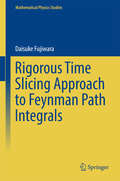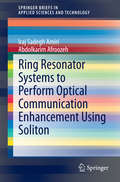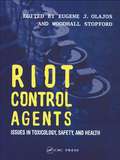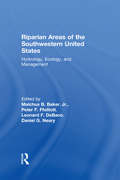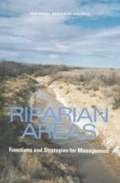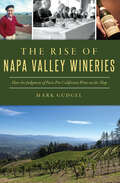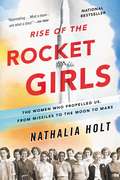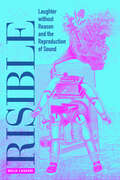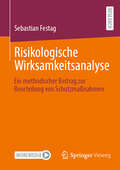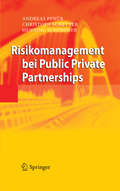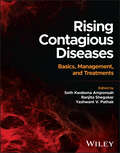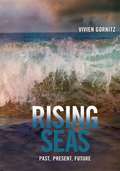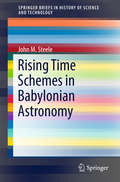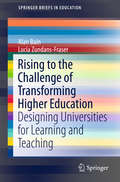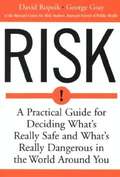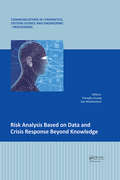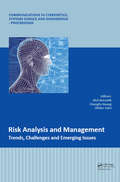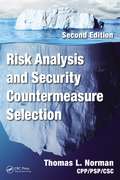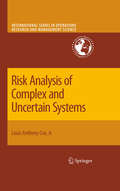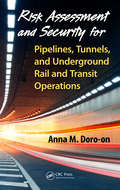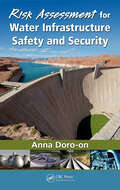- Table View
- List View
Rigorous Time Slicing Approach to Feynman Path Integrals
by Daisuke FujiwaraThis book proves that Feynman's original definition of the path integral actually converges to the fundamental solution of the Schr#65533;dinger equation at least in the short term if the potential is differentiable sufficiently many times and its derivatives of order equal to or higher than two are bounded. The semi-classical asymptotic formula up to the second term of the fundamental solution is also proved by a method different from that of Birkhoff. A bound of the remainder term is also proved. The Feynman path integral is a method of quantization using the Lagrangian function, whereas Schr#65533;dinger's quantization uses the Hamiltonian function. These two methods are believed to be equivalent. But equivalence is not fully proved mathematically, because, compared with Schr#65533;dinger's method, there is still much to be done concerning rigorous mathematical treatment of Feynman's method. Feynman himself defined a path integral as the limit of a sequence of integrals over finite-dimensional spaces which is obtained by dividing the time interval into small pieces. This method is called the time slicing approximation method or the time slicing method. This book consists of two parts. Part I is the main part. The time slicing method is performed step by step in detail in Part I. The time interval is divided into small pieces. Corresponding to each division a finite-dimensional integral is constructed following Feynman's famous paper. This finite-dimensional integral is not absolutely convergent. Owing to the assumption of the potential, it is an oscillatory integral. The oscillatory integral techniques developed in the theory of partial differential equations are applied to it. It turns out that the finite-dimensional integral gives a finite definite value. The stationary phase method is applied to it. Basic properties of oscillatory integrals and the stationary phase method are explained in the book in detail. Those finite-dimensional integrals form a sequence of approximation of the Feynman path integral when the division goes finer and finer. A careful discussion is required to prove the convergence of the approximate sequence as the length of each of the small subintervals tends to 0. For that purpose the book uses the stationary phase method of oscillatory integrals over a space of large dimension, of which the detailed proof is given in Part II of the book. By virtue of this method, the approximate sequence converges to the limit. This proves that the Feynman path integral converges. It turns out that the convergence occurs in a very strong topology. The fact that the limit is the fundamental solution of the Schr#65533;dinger equation is proved also by the stationary phase method. The semi-classical asymptotic formula naturally follows from the above discussion. A prerequisite for readers of this book is standard knowledge of functional analysis. Mathematical techniques required here are explained and proved from scratch in Part II, which occupies a large part of the book, because they are considerably different from techniques usually used in treating the Schr#65533;dinger equation.
Ring Resonator Systems to Perform Optical Communication Enhancement Using Soliton
by Iraj Sadegh Amiri Abdolkarim AfroozehThe title explain new technique of secured and high capacity optical communication signals generation by using the micro and nano ring resonators. The pulses are known as soliton pulses which are more secured due to having the properties of chaotic and dark soliton signals with ultra short bandwidth. They have high capacity due to the fact that ring resonators are able to generate pulses in the form of solitons in multiples and train form. These pulses generated by ring resonators are suitable in optical communication due to use the compact and integrated rings system, easy to control, flexibility, less loss, application in long distance communication and many other advantages. Using these pulses overcome the problems such as losses during the propagation, long distances, error detection, using many repeaters or amplifiers, undetectable received signals, pulse broadening, overlapping and so on. This book show how to generate soliton pulses using ring resonators in the micro and nano range which can be used in optical communication to improve the transmission technique and quality of received signals in networks such as WiFi and wireless communication.
Ring! Ring!
by Gill GuileThis board book will captivate and amuse. The repetitive "Ring! Ring!" and simple storyline will encourage basic reading skills.
Riot Control Agents: Issues in Toxicology, Safety & Health
by Eugene J. Olajos Woodhall StopfordThe proliferation and sophistication of riot control chemicals mean that all parties need to understand the responsible use and effects of such compounds. This book provides practical information on the history, chemistry, and biology of riot control agents and discusses their biological actions, risk assessment issues, and recent technical develop
Riparian Areas of the Southwestern United States: Hydrology, Ecology, and Management
by Peter F. Ffolliott Malchus B. Baker Leonard F. DeBano Daniel G. NearyThe demand for water resulting from massive population and economic growth in the southwestern U.S. overwhelmed traditional uses of riparian areas. As a consequence, many of these uniquely-structured ecosystems have been altered or destroyed. Within recent years people have become increasingly aware of the many uses and benefits of riparian zones a
Riparian Areas: Functions and Strategies for Management
by Committee on Riparian Zone Functioning Strategies For ManagementThe Clean Water Act (CWA) requires that wetlands be protected from degradation because of their important ecological functions including maintenance of high water quality and provision of fish and wildlife habitat. However, this protection generally does not encompass riparian areas--the lands bordering rivers and lakes--even though they often provide the same functions as wetlands. Growing recognition of the similarities in wetland and riparian area functioning and the differences in their legal protection led the NRC in 1999 to undertake a study of riparian "areas, which has culminated in Riparian Areas: Functions and Strategies for Management. The report is intended to heighten awareness of riparian areas commensurate with their ecological and societal values. The primary conclusion is that, because riparian areas perform a disproportionate number of biological and physical functions on a unit area basis, restoration of riparian functions along America's waterbodies should be a national goal.
Rise of Napa Valley Wineries, The: How the Judgment of Paris Put California Wine on the Map (American Palate)
by Mark GudgelA wine country odyssey. In 1976, the picturesque, agrarian Napa Valley was all but unknown to those who didn't live there. That changed dramatically when Steven Spurrier and Patricia Gallagher decided to host a blind tasting of American and French wines in Paris. When wines from California defeated those of France, the world was shocked, an industry reawakened, and Napa Valley exploded in a frenzy of growth and development. Families who had farmed for generations battled to hang onto their land, and many paid a steep price as the area transformed into one of the world's premier wine-growing regions. Join author Mark Gudgel as he explores the trials and tribulations of Napa's meteoric rise to prominence.
Rise of the Red Hand (The Mechanists #1)
by Olivia ChadhaA rare, searing portrayal of the future of climate change in South Asia. A streetrat turned revolutionary and the disillusioned hacker son of a politician try to take down a ruthlessly technocratic government that sacrifices its poorest citizens to build its utopia. The South Asian Province is split in two. Uplanders lead luxurious lives inside a climate-controlled biodome, dependent on technology and gene therapy to keep them healthy and youthful forever. Outside, the poor and forgotten scrape by with discarded black-market robotics, a society of poverty-stricken cyborgs struggling to survive in slums threatened by rising sea levels, unbreathable air, and deadly superbugs. Ashiva works for the Red Hand, an underground network of revolutionaries fighting the government, which is run by a merciless computer algorithm that dictates every citizen&’s fate. She&’s a smuggler with the best robotic arm and cybernetic enhancements the slums can offer, and her cargo includes the most vulnerable of the city&’s abandoned children. When Ashiva crosses paths with the brilliant hacker Riz-Ali, a privileged Uplander who finds himself embroiled in the Red Hand&’s dangerous activities, they uncover a horrifying conspiracy that the government will do anything to bury. From armed guardians kidnapping children to massive robots flattening the slums, to a pandemic that threatens to sweep through the city like wildfire, Ashiva and Riz-Ali will have to put aside their differences in order to fight the system and save the communities they love from destruction.
Rise of the Red Hand (The\mechanists Ser.)
by Olivia Chadha&“Steeped in elements from real-life South Asian cultures, the worldbuilding is original and intriguing, incorporating dystopian and utopian elements along with current hot issues such as societal inequities, digital surveillance, and technology&’s impact on humanity. . . . [A] strong and intricate story.&” —Kirkus Reviews This 2022 Colorado Book Award Winner is a rare, searing portrayal of the future of climate change in South Asia. A streetrat turned revolutionary and the disillusioned hacker son of a politician try to take down a ruthlessly technocratic government that sacrifices its poorest citizens to build its utopia. The South Asian Province is split in two. Uplanders live in a luxurious, climate-controlled biodome, healthy and artificially youthful forever. Outside, the poor and forgotten scrape by with black-market robotics, in slums threatened by rising sea levels, unbreathable air, and deadly superbugs. Ashiva works for the Red Hand, an underground network of revolutionaries fighting the government, which is run by a merciless computer algorithm. As a smuggler with the best robotic arm and cybernetic enhancements the slums can offer, her cargo includes the city&’s most vulnerable abandoned children. When the brilliant Uplander hacker Riz-Ali stumbles into the Red Hand&’s dangerous activities, he and Ashiva uncover a horrifying conspiracy that the government will do anything to bury. As armed guardians kidnap children, massive robots flatten the slums, and a pandemic threatens to decimate the city, Ashiva and Riz must put aside their differences to fight the system and save the communities they love.
Rise of the Rocket Girls: The Women Who Propelled Us, from Missiles to the Moon to Mars
by Nathalia HoltThe riveting true story of the women who launched America into space. In the 1940s and 50s, when the newly minted Jet Propulsion Laboratory needed quick-thinking mathematicians to calculate velocities and plot trajectories, they didn't turn to male graduates. <P><P>Rather, they recruited an elite group of young women who, with only pencil, paper, and mathematical prowess, transformed rocket design, helped bring about the first American satellites, and made the exploration of the solar system possible. <P><P> For the first time, Rise of the Rocket Girls tells the stories of these women--known as "human computers"--who broke the boundaries of both gender and science. Based on extensive research and interviews with all the living members of the team, Rise of the Rocket Girls offers a unique perspective on the role of women in science: both where we've been, and the far reaches of space to which we're heading.
Risible: Laughter without Reason and the Reproduction of Sound
by Delia CasadeiA free ebook version of this title is available through Luminos, University of California Press’s Open Access publishing program. Visit www.luminosoa.org to learn more.Risible explores the forgotten history of laughter, from ancient Greece to the sitcom stages of Hollywood. Delia Casadei approaches laughter not as a phenomenon that can be accounted for by studies of humor and theories of comedy but rather as a technique of the human body, knowable by its repetitive, clipped, and proliferating sound and its enduring links to the capacity for language and reproduction. This buried genealogy of laughter re-emerges with explosive force thanks to the binding of laughter to sound reproduction technology in the late nineteenth century. Analyzing case studies ranging from the early global market for phonographic laughing songs to the McCarthy-era rise of prerecorded laugh tracks, Casadei convincingly demonstrates how laughter was central to the twentieth century’s development of the very category of sound as not-quite-human, unintelligible, reproductive, reproducible, and contagious.
Risikologische Wirksamkeitsanalyse: Ein methodischer Beitrag zur Beurteilung von Schutzmaßnahmen
by Sebastian FestagFür die Auseinandersetzung mit Gefährdungen gibt es methodische und systematische Vorgehensweisen. Werden Schutzmaßnahmen gegen Gefährdungen ergriffen, so ist deren Wirksamkeit zu überprüfen. Hierfür gibt es nur wenige Orientierungspunkte und methodische Standards. In der Praxis wird der Wirksamkeitskontrolle häufig nicht ausreichend Aufmerksamkeit geschenkt. Folglich existieren Schutzmaßnahmen mit einer ganzen Bandbreite von Wirkungen, von hochwirksam bis zu kontraproduktiv. Die Wirksamkeit einer Maßnahme lässt sich über die Wirksamkeitskontrolle ermitteln. Die vorliegende Arbeit fasst die zu beachtenden Grundlagen zusammen und liefert ein methodisches Fundament zur empirischen Durchführung solcher Kontrollen, um über einen methodischen Querschnittsbeitrag die Reduzierung von Gefährdungen zu unterstützen. Nach der theoretischen Hinführung in die Thematik der Wirksamkeitskontrolle wird die praktische Durchführung anhand von unterschiedlichen Schutzmaßnahmen in verschiedenen Anwendungsbereichen demonstriert. Mit diesen Fallanalysen wird die Bandbreite der Optionen zur Bewertung der Wirksamkeit abgebildet. Darauf basierend werden die wesentlichen Linien zur Weiterentwicklung der Wirksamkeitskontrolle beschrieben.
Risikomanagement bei Public Private Partnerships
by Andreas Pfnür Christoph Schetter Henning SchöbenerDer Band beschäftigt sich mit dem Risikomangement bei öffentlichen Infrastrukturinvestitionen, insbesondere bei öffentlich-privaten Partnerschaften. Dabei legen die Autoren großen Wert auf Verständlichkeit und praktischen Nutzen: Leser sollen befähigt werden, Risikoidentifikation und -bewertung sowie das Risikomanagement selbst durchzuführen. Dabei wird der gesamte Lebenszyklus der Investition betrachtet, Verfahren der simulativen Risikoanalyse diskutiert sowie die Möglichkeiten und Grenzen des Handels mit Projektrisiken am Kapitalmarkt ausgelotet.
Rising Contagious Diseases: Basics, Management, and Treatments
by Ranjita Shegokar Yashwant V. Pathak Seth Kwabena AmponsahComprehensive yet succinct insight into the prevention, diagnosis, and treatment of infectious diseases including COVID-19, mpox, Ebola, and Lyme disease Rising Contagious Diseases provides basic information about preventing and treating threatening infectious diseases from viral, bacterial, and parasitic sources, including 28 emerging or recurring diseases like COVID-19, mpox, Ebola, bird and swine flu, malaria, Legionnaires', and others. The text highlights molecular surveillance and epidemiology (including zoonotic pathogens or their variants), innovative strategies for pathogen detection, drug and vaccine development, appropriate preventive measures, cost-effective diagnostic procedures (assays), and effective therapeutic strategies. The text is unique due to its broad coverage of today’s infectious diseases, covering several which are not similarly addressed elsewhere, with detailed insight from experts around the world. Composed of 30 chapters of fundamental facts alongside practical and clinical data, Rising Contagious Diseases covers sample topics such as: Re-emergence of certain diseases in recent decades due to dynamic host-pathogen interactions, anthropogenic selection, and climate change How real-time epidemiological surveillance can improve detection of infectious disease outbreaks or new infections of public health importance Up-to-date insight on transmission dynamics, epidemiology, clinical manifestation, advances in diagnostics, and management of covered diseases Effects of disease outbreaks on the world at large, such as through high morbidity and mortality rates and rising healthcare costs With detailed insight on the prevention, diagnosis, and treatment of infectious diseases, Rising Contagious Diseases is an essential reference for health care professionals, academics in the field of microbiology, immunology, infectious diseases, pathology, pharmacology and public health, and undergraduates and postgraduates in related disciplines.
Rising Seas: Past, Present, Future
by Vivien GornitzThe Earth's climate is already warming due to increased concentrations of human-produced greenhouse gases in the atmosphere, and the specter of rising sea level is one of global warming's most far-reaching threats. Sea level will keep rising long after greenhouse gas emissions have ceased, because of the delay in penetration of surface warming to the ocean depths and because of the slow dissipation of excess atmospheric carbon dioxide. Adopting a long perspective that interprets sea level changes both underway and expected in the near future, Vivien Gornitz completes a highly relevant and necessary study of an unprecedented age in Earth's history.Gornitz consults past climate archives to help better anticipate future developments and prepare for them more effectively. She focuses on several understudied historical events, including the Paleocene-Eocene Thermal Anomaly, the Messinian salinity crisis, the rapid filling of the Black Sea (which may have inspired the story of Noah's flood), and the Storrega submarine slide, an incident possibly connected to a sea level occurrence roughly 8,000 years old. By examining dramatic variations in past sea level and climate, Gornitz concretizes the potential consequences of rapid, human-induced warming. She builds historical precedent for coastal hazards associated with a higher ocean level, such as increased damage from storm surge flooding, even if storm characteristics remain unchanged. Citing the examples of Rotterdam, London, New York City, and other forward-looking urban centers that are effectively preparing for higher sea level, Gornitz also delineates the difficult economic and political choices of curbing carbon emissions while underscoring, through past geological analysis, the urgent need to do so.
Rising Time Schemes in Babylonian Astronomy
by John M. SteeleThis revealing work examines an approach from ancient astronomy to what was then a particularly important question, namely that of understanding the relationship between the position in the ecliptic and the time it takes for a fixed-length of the ecliptic beginning at that point to rise above the eastern horizon. Schemes known as "rising time schemes" were used to give lengths of the celestial equator corresponding to each of the twelve zodiacal signs which make up the ecliptic. This book investigates the earliest known examples of these schemes which come from Babylonia and date to the mid to late first millennium BC. Making an important contribution to our knowledge of astronomy in the ancient world, this volume includes editions and translations of all of the known Babylonian rising time texts, including several texts that are identified for the first time. Through a close examination of the preserved texts it has been possible to reconstruct the complete Babylonian rising time scheme. This reconstruction is unprecedented in its completeness, and it is also now possible to situate the scheme within a genre of Babylonian astronomy known as schematic astronomy which presents theoretical descriptions of the astronomical phenomena. The unique discoveries and fresh explorations in this book will be of interest to historians of ancient astronomy, scholars of Babylonian history and those investigating the origins of scientific thought.
Rising to the Challenge of Transforming Higher Education
by Alan Bain Lucia Zundans-FraserCreating a successful and distinctive approach to learning and teaching at scale is a challenge facing all universities. This brief presents the Self-Organizing University (SOU), a transformational whole-of-organization solution for the design, delivery, and evaluation of learning and teaching in all its forms. It describes the elements of the SOU approach along with the implementation process and expected outcomes. It also explains the rationale and research base for each element of the model and how they are connected to create a university-wide model of learning and teaching. It includes guidance for anyone responsible for institutional improvement in the learning and teaching space.
Risk
by George Gray David RopeikAn indispensable and timely guide, Risk is the authority for assessing threats to your health and safety.We continually face new risks in our world. This essential family reference will help you understand worrisome risks so you can decide how to stay safe and how to keeps risks in perspective. Expert authors David Ropeik and George Gray include information on:- 50 top hazards - your likelihood of exposure - the consequences - ways to reduce your riskThey cover topics such as:- cancer - biological weapons - indoor air pollution - pesticides - radiation
Risk Analysis Based on Data and Crisis Response Beyond Knowledge: Proceedings of the 7th International Conference on Risk Analysis and Crisis Response (RACR 2019), October 15-19, 2019, Athens, Greece
by Chongfu Huang Zoe S. NivolianitouThis book collects the papers presented at the 7th International Conference on Risk Analysis and Crisis Response (RACR-2019) held in Athens, Greece, on October 15-19, 2019. The overall theme of the seventh international conference on risk analysis and crisis response is Risk Analysis Based on Data and Crisis Response Beyond Knowledge, highlighting science and technology to improve risk analysis capabilities and to optimize crisis response strategy. This book contains primarily research articles of risk issues. Underlying topics include natural hazards and major (chemical) accidents prevention, disaster risk reduction and society resilience, information and communication technologies safety and cybersecurity, modern trends in crisis management, energy and resources security, critical infrastructure, nanotechnology safety and others. All topics include aspects of multidisciplinarity and complexity of safety in education and research. The book should be valuable to professors, engineers, officials, businessmen and graduate students in risk analysis and risk management.
Risk Analysis and Management - Trends, Challenges and Emerging Issues: Proceedings of the 6th International Conference on Risk Analysis and Crisis Response (RACR 2017), June 5-9, 2017, Ostrava, Czech Republic
by Ales Bernatik Chongfu Huang Olivier SalviThis book collects the papers presented at the 6th International Conference on Risk Analysis and Crisis Response (RACR-2017) held in Ostrava/Prague, Czech Republic, on June 5-9, 2017, organized by VSB-Technical University of Ostrava, Czech Republic. The overall theme of the sixth international conference on risk analysis and crisis response is Risk Analysis and Management – Trends, Challenges and Emerging Issues, highlighting science and technology to improve risk analysis capabilities and to optimize crisis response strategy.This book contains primarily research articles of risk issues. Underlying topics include natural hazards and major (chemical) accidents prevention, disaster risk reduction and society resilience, information and communication technologies safety and cybersecurity, modern trends in crisis management, energy and resources security, critical infrastructure, nanotechnology safety and others. All topics include aspects of multidisciplinarity and complexity of safety in education and research. The book should be valuable to professors, engineers, officials, businessmen and graduate students in risk analysis and risk management. About the book series Communications in Cybernetics, Systems Science and Engineering - Proceedings (CCSSEP) is a cross-disciplinary book series devoted to theoretical and applied research contributions, that cater to a rapidly growing worldwide interest in a cybernetic and systemic methodology with an ever-increasing capacity to deal with new challenges in a way that traditional science cannot. The series aims to become a comprehensive reference work on and guide to developments within the field and strategies required for better implementation of advances, with a view to environmental protection and sustainable social and economic development. The CCSSE series targets all working in theoretical and applied fields of cybernetics, systems science and engineering, e.g. academics, researchers and consultants, computer and information scientists, development and systems engineers, mathematicians, management cyberneticists and systemists, medical scientists, and intelligent and manufacturing engineers in industry, as well as leading decision- and policy-makers. Series editor: Jeffrey ‘Yi-Lin’ Forrest
Risk Analysis and Security Countermeasure Selection
by Thomas L. Norman CPP/PSP/CSCThis new edition of Risk Analysis and Security Countermeasure Selection presents updated case studies and introduces existing and new methodologies and technologies for addressing existing and future threats. It covers risk analysis methodologies approved by the U.S. Department of Homeland Security and shows how to apply them to other organizations
Risk Analysis of Complex and Uncertain Systems
by Louis Anthony Cox Jr.In Risk Analysis of Complex and Uncertain Systems acknowledged risk authority Tony Cox shows all risk practitioners how Quantitative Risk Assessment (QRA) can be used to improve risk management decisions and policies. It develops and illustrates QRA methods for complex and uncertain biological, engineering, and social systems - systems that have behaviors that are just too complex to be modeled accurately in detail with high confidence - and shows how they can be applied to applications including assessing and managing risks from chemical carcinogens, antibiotic resistance, mad cow disease, terrorist attacks, and accidental or deliberate failures in telecommunications network infrastructure. This book was written for a broad range of practitioners, including decision risk analysts, operations researchers and management scientists, quantitative policy analysts, economists, health and safety risk assessors, engineers, and modelers.
Risk Assessment and Security for Pipelines, Tunnels, and Underground Rail and Transit Operations
by Anna M. Doro-onRisk Assessment and Security for Pipelines, Tunnels, and Underground Rail and Transit Operations details a quantitative risk assessment methodology for systematically analyzing various alternatives for protecting underground rail, oil and gas pipelines, pipeline freight transportation, and other tunnel systems from terrorism threats and other disas
Risk Assessment for Water Infrastructure Safety and Security
by Anna Doro-onOne of the seventeen critical infrastructures vital to the security of the United States, the water supply system remains largely unprotected from the threat of terrorism, including possible revenge by Al Qaeda over the killing of Osama Bin Laden. Recognizing and identifying prospective events of terrorism against the water infrastructure is critic
Risk Assessment of Dams (Springer Tracts in Civil Engineering)
by Aytaç Güven Alper AydemirThis book offers a timely report on methods for risk assessment procedures for dams, with a special emphasis on dams with small storage dimensions. It starts by introducing all important definitions relating to dams, dam safety, such as the most common failure modes, and risks. In turn, it describes in detail the most important evaluation procedures for various failure modes such as piping, flood, earthquake and stability are described in this chapter. Consequence assessment procedures, together with the different steps of the risk evaluation process, are analyzed, providing a guide on how to identify the appropriate failure mode for the examined dam and setting up the appropriate safety plan. The book introduces the most common methods for predicting peak breach discharge, analyzing some relevant case studies. Upon comparing the findings obtained with the different methods, the book concludes with some general suggestions and ideas for future developments. This book fills an important gap between theoretical works and real-life problems being investigating in practical research studies on dam safety and risk management. It provides readers with the necessary knowledge on risk analysis and shows how to apply this in practice to carry out dam safety studies. It offers practical guidelines to set up risk assessment procedures for different failure modes and predicting failure parameters such as failure time, peak breach discharge and breach width.
